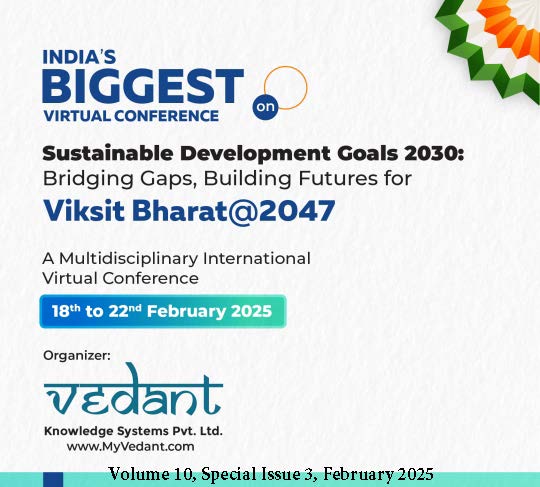Sustainable Development Goals 2030: "Bridging Gaps, Building Futures for Viksit Bharat@2047"
DOI:
https://doi.org/10.58213/vidhyayana.v10isi3.2240Abstract
The Sustainable Development Goals (SDGs), launched by the United Nations in 2015, represent a comprehensive and ambitious agenda designed to promote peace, prosperity, and sustainability for people and the planet alike. This framework encompasses 17 interconnected goals that address global challenges such as poverty, inequality, climate change, environmental degradation, peace, and justice. Each goal is accompanied by specific targets and indicators to measure progress and ensure accountability among nations. As India forges ahead on its developmental path, its vision of Viksit Bharat@2047 becomes increasingly relevant. This initiative aims to transform the nation into a prosperous and developed society by the 100th anniversary of its independence, fostering inclusive growth and improving the overall quality of life for all citizens. The SDGs serve as a strategic guide in this endeavor, providing a roadmap that aligns with India's aspirations for sustainable development. However, despite the alignment of the Viksit Bharat vision with the SDGs, there are significant gaps and challenges that must be addressed to ensure meaningful progress. These gaps include disparities in wealth distribution, inadequate access to quality education and healthcare, environmental degradation, and the need for a more robust and integrated approach to governance and policy implementation. To tackle these challenges, this article critically analyzes the existing barriers to the advancement of the SDGs in India. It delves into the socio-economic and political factors that contribute to these obstacles, highlighting the urgent need for policy reforms and collaborative efforts across sectors. Furthermore, it outlines strategic formulations aimed at overcoming these impediments, such as enhancing public-private partnerships, investing in sustainable technologies, and fostering community engagement in decision-making processes. The article concludes by proposing a detailed and actionable roadmap that outlines the steps necessary to realize the vision of Viksit Bharat@2047. This roadmap emphasizes the importance of holistic development, equitable resource distribution, and the integration of sustainable practices into all facets of the economy and society. By embracing this comprehensive approach, India can take significant strides toward achieving the SDGs and ensuring a prosperous future for all its citizens.
Downloads
References
• United Nations. (2015). Sustainable Development Goals. Retrieved from UN SDGs
• Government of India. (2021). Viksit Bharat@2047. Retrieved from Viksit Bharat
• Various reports and articles on healthcare, education, agriculture, gender equality, and urban development in India.
Vernacular Publications:
• "SDG Bharat" (SDG India) - A series of articles published in various regional languages across India, highlighting local efforts and progress towards achieving SDGs. (2020)
• "Sustainable Development Goals: A Vernacular Perspective" - Articles and reports published in regional newspapers and magazines discussing SDGs in the context of local cultures and languages. (periodical publications)
Magazines and Journals:
• "Inspiring India Magazine" by UNDP India - This magazine showcases inspiring stories of change and voices from across India towards creating a sustainable future. (first published in 2022. The second edition was released on March 23, 2023.)
• "Vision IAS Current Affairs" - Monthly magazine that covers various topics including SDGs and their progress in India. (monthly magazine has been published since 2017.)
• "Clear IAS" - An online platform that provides comprehensive articles and updates on SDGs, including the SDG India Index. (4th Publication, published on July 14, 2024)
Journals:
• "India's Sustainable Development Goal Journey: Progress and Pathways" - Published by SpringerLink, this journal provides a comprehensive assessment of India's progress towards SDGs. ( first published online on August 28, 2024 as part of the book series "Studies in Systems, Decision and Control" by SpringerLink)
• "Studies in Systems, Decision and Control" - This journal includes chapters on India's SDG journey and the challenges faced. (The publication dates for individual volumes vary, but the series has been active from 2014 to 2024)
IJEEKS (International Journal of Emerging Knowledge Studies):
• "The Survey of Traditional Medicinal Plants Used for Various Treatments in the Peoples of Thandrampattu Taluk, Thiruvannamalai District, Tamilnadu, India" - Authors: (Dr. R. Rooban, Dr. M. Santhosh Kumar, and Dr. M. Arivalagan-2024)
• "Digital Engagement and Techno Wellness Amongst Youth: A Review Paper on the Current Era" - Authors: (Dr. Chandrani Sen and Danish Alam-2024)
• "Impact of Decision-Making Abilities on Promoting Successful Aging: A Multidimensional Perspective" - Author: (Taniya Shekhawat-2024)
UGC-CARE List:
• "Assessment of Barriers to Access and Utilization of Reproductive and Child Healthcare Services in Sub-Saharan Africa: A Review" - Authors:( Halidu Imurana and Dr. Anoop Kumar Bhartiya-2024)
• "Salience of Buddhism as an Instrument of Soft Power in India's Neighborhood" - Authors: (Manjul Mishra and Keshav Mishra-2024)
• "Promoting Creativity and Collaboration: Innovative Interdisciplinary Approaches to Enhance STEM Education and Critical Thinking in Students" – (Author: Dr. Kumari Nisha Singh-2024)
SHODHGANGA:
• "Information Seeking Behaviour of B.Ed Colleges in Haryana State: A Study" - Author: (Rajwanti Vashistha Rajeev-2022)
• "Sevarsh Ke Shishuon Ke Poshan Star Ko Ooncha Uthane Mein Samekit Bal Vikas Seva Yojana Ka Prayas Darabhanga Prakhand Ke Sandarbh Mein Ek Sarvekshanatmak Adhyayan" - Authors: (Jha, Nirmala Jha, Kumari Reena-2012)
• "A Study of Curriculum of India a
• nd Finland Elementary School" - Authors: (Poonam Yadav and Preeti Sharma-2022)
